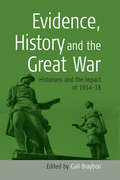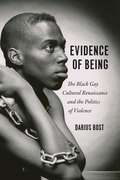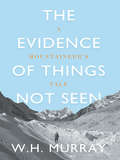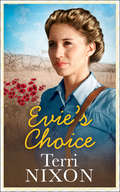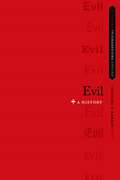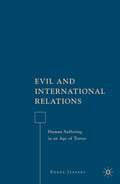- Table View
- List View
Evidence for Hope: Making Human Rights Work in the 21st Century (Human Rights and Crimes against Humanity #28)
by Kathryn SikkinkA history of the successes of the human rights movement and a case for why human rights workEvidence for Hope makes the case that, yes, human rights work. Critics may counter that the movement is in serious jeopardy or even a questionable byproduct of Western imperialism. They point out that Guantánamo is still open, the Arab Spring protests have been crushed, and governments are cracking down on NGOs everywhere. But respected human rights expert Kathryn Sikkink draws on decades of research and fieldwork to provide a rigorous rebuttal to pessimistic doubts about human rights laws and institutions. She demonstrates that change comes slowly and as the result of struggle, but in the long term, human rights movements have been vastly effective.Attacks on the human rights movement’s credibility are based on the faulty premise that human rights ideas emerged in North America and Europe and were imposed on developing southern nations. Starting in the 1940s, Latin American leaders and activists were actually early advocates for the international protection of human rights. Sikkink shows that activists and scholars disagree about the efficacy of human rights because they use different yardsticks to measure progress. Comparing the present to the past, she shows that genocide and violence against civilians have declined over time, while access to healthcare and education has increased dramatically. Cognitive and news biases contribute to pervasive cynicism, but Sikkink’s investigation into past and current trends indicates that human rights is not in its twilight. Instead, this is a period of vibrant activism that has made impressive improvements in human well-being.Exploring the strategies that have led to real humanitarian gains since the middle of the twentieth century, Evidence for Hope looks at how these essential advances can be supported and sustained for decades to come.
Evidence for Hope: Making Human Rights Work in the 21st Century (Human Rights and Crimes against Humanity)
by Kathryn SikkinkA history of the successes of the human rights movement and a case for why human rights workEvidence for Hope makes the case that, yes, human rights work. Critics may counter that the movement is in serious jeopardy or even a questionable byproduct of Western imperialism. They point out that Guantánamo is still open, the Arab Spring protests have been crushed, and governments are cracking down on NGOs everywhere. But respected human rights expert Kathryn Sikkink draws on decades of research and fieldwork to provide a rigorous rebuttal to pessimistic doubts about human rights laws and institutions. She demonstrates that change comes slowly and as the result of struggle, but in the long term, human rights movements have been vastly effective.Attacks on the human rights movement’s credibility are based on the faulty premise that human rights ideas emerged in North America and Europe and were imposed on developing southern nations. Starting in the 1940s, Latin American leaders and activists were actually early advocates for the international protection of human rights. Sikkink shows that activists and scholars disagree about the efficacy of human rights because they use different yardsticks to measure progress. Comparing the present to the past, she shows that genocide and violence against civilians have declined over time, while access to healthcare and education has increased dramatically. Cognitive and news biases contribute to pervasive cynicism, but Sikkink’s investigation into past and current trends indicates that human rights is not in its twilight. Instead, this is a period of vibrant activism that has made impressive improvements in human well-being.Exploring the strategies that have led to real humanitarian gains since the middle of the twentieth century, Evidence for Hope looks at how these essential advances can be supported and sustained for decades to come.
Evidence, History and the Great War: Historians and the Impact of 1914-18
by Gail BraybonIn the English-speaking world the Great War maintains a tenacious grip on the public imagination, and also continues to draw historians to an event which has been interpreted variously as a symbol of modernity, the midwife to the twentieth century and an agent of social change. Although much 'common knowledge' about the war and its aftermath has included myth, simplification and generalisation, this has often been accepted uncritically by popular and academic writers alike. While Britain may have suffered a surfeit of war books, many telling much the same story, there is far less written about the impact of the Great War in other combatant nations. Its history was long suppressed in both fascist Italy and the communist Soviet Union: only recently have historians of Russia begun to examine a conflict which killed, maimed and displaced so many millions. Even in France and Germany the experience of 1914-18 has often been overshadowed by the Second World War. The war's social history is now ripe for reassessment and revision. The essays in this volume incorporate a European perspective, engage with the historiography of the war, and consider how the primary textural, oral and pictorial evidence has been used - or abused. Subjects include the politics of shellshock, the impact of war on women, the plight of refugees, food distribution in Berlin and portrait photography, all of which illuminate key debates in war history.
Evidence in Action between Science and Society: Constructing, Validating, and Contesting Knowledge (Routledge Studies in the History of Science, Technology and Medicine)
by Sarah EhlersThis volume is an interdisciplinary attempt to insert a broader, historically informed perspective into current political and academic debates on the issue of evidence and the reliability of scientific knowledge. The tensions between competing paradigms, different bodies of knowledge and the relative hierarchies between them are a crucial element of the historical and contemporary dynamics of scientific knowledge production. The negotiation of evidence is at the heart of this process. Starting from the premise that evidence constitutes a central, but also essentially contested concept in contemporary knowledge-based societies, this volume focuses on how evidence is generated and applied in practice – in other words, on "evidence in action". The contributions analyze and compare different evidence practices within the field of science and technology, how they interlink with different forms of power, their interaction with and impact on the legal and political domain, and their relationship to other, more heterodox forms of evidence that challenge traditional notions of evidence. In doing so, this volume provides much-needed context and historical background to contemporary debates on the so-called "post-truth" society. Evidence in Action is the perfect resource for all those interested in the relationship between science, technology, and the role of knowledge in society.
Evidence in Action between Science and Society: Constructing, Validating, and Contesting Knowledge (Routledge Studies in the History of Science, Technology and Medicine)
by Sarah Ehlers Stefan EsselbornThis volume is an interdisciplinary attempt to insert a broader, historically informed perspective into current political and academic debates on the issue of evidence and the reliability of scientific knowledge. The tensions between competing paradigms, different bodies of knowledge and the relative hierarchies between them are a crucial element of the historical and contemporary dynamics of scientific knowledge production. The negotiation of evidence is at the heart of this process. Starting from the premise that evidence constitutes a central, but also essentially contested concept in contemporary knowledge-based societies, this volume focuses on how evidence is generated and applied in practice – in other words, on "evidence in action". The contributions analyze and compare different evidence practices within the field of science and technology, how they interlink with different forms of power, their interaction with and impact on the legal and political domain, and their relationship to other, more heterodox forms of evidence that challenge traditional notions of evidence. In doing so, this volume provides much-needed context and historical background to contemporary debates on the so-called "post-truth" society. Evidence in Action is the perfect resource for all those interested in the relationship between science, technology, and the role of knowledge in society.
Evidence in the Age of the New Sciences (International Archives of the History of Ideas Archives internationales d'histoire des idées #225)
by James A.T. Lancaster Richard RaiswellThe motto of the Royal Society—Nullius in verba—was intended to highlight the members’ rejection of received knowledge and the new place they afforded direct empirical evidence in their quest for genuine, useful knowledge about the world. But while many studies have raised questions about the construction, reception and authentication of knowledge, Evidence in the Age of the New Sciences is the first to examine the problem of evidence at this pivotal moment in European intellectual history. What constituted evidence—and for whom? Where might it be found? How should it be collected and organized? What is the relationship between evidence and proof? These are crucial questions, for what constitutes evidence determines how people interrogate the world and the kind of arguments they make about it.In this important new collection, Lancaster and Raiswell have assembled twelve studies that capture aspects of the debate over evidence in a variety of intellectual contexts. From law and theology to geography, medicine and experimental philosophy, the chapters highlight the great diversity of approaches to evidence-gathering that existed side by side in the sixteenth and seventeenth centuries. In this way, the volume makes an important addition to the literature on early science and knowledge formation, and will be of particular interest to scholars and advanced students in these fields.
Evidence of Being: The Black Gay Cultural Renaissance and the Politics of Violence
by Darius BostEvidence of Being opens on a grim scene: Washington DC’s gay black community in the 1980s, ravaged by AIDS, the crack epidemic, and a series of unsolved murders, seemingly abandoned by the government and mainstream culture. Yet in this darkest of moments, a new vision of community and hope managed to emerge. Darius Bost’s account of the media, poetry, and performance of this time and place reveals a stunning confluence of activism and the arts. In Washington and New York during the 1980s and ’90s, gay black men banded together, using creative expression as a tool to challenge the widespread views that marked them as unworthy of grief. They created art that enriched and reimagined their lives in the face of pain and neglect, while at the same time forging a path toward bold new modes of existence. At once a corrective to the predominantly white male accounts of the AIDS crisis and an openhearted depiction of the possibilities of black gay life, Evidence of Being above all insists on the primacy of community over loneliness, and hope over despair.
Evidence of Being: The Black Gay Cultural Renaissance and the Politics of Violence
by Darius BostEvidence of Being opens on a grim scene: Washington DC’s gay black community in the 1980s, ravaged by AIDS, the crack epidemic, and a series of unsolved murders, seemingly abandoned by the government and mainstream culture. Yet in this darkest of moments, a new vision of community and hope managed to emerge. Darius Bost’s account of the media, poetry, and performance of this time and place reveals a stunning confluence of activism and the arts. In Washington and New York during the 1980s and ’90s, gay black men banded together, using creative expression as a tool to challenge the widespread views that marked them as unworthy of grief. They created art that enriched and reimagined their lives in the face of pain and neglect, while at the same time forging a path toward bold new modes of existence. At once a corrective to the predominantly white male accounts of the AIDS crisis and an openhearted depiction of the possibilities of black gay life, Evidence of Being above all insists on the primacy of community over loneliness, and hope over despair.
Evidence of Being: The Black Gay Cultural Renaissance and the Politics of Violence
by Darius BostEvidence of Being opens on a grim scene: Washington DC’s gay black community in the 1980s, ravaged by AIDS, the crack epidemic, and a series of unsolved murders, seemingly abandoned by the government and mainstream culture. Yet in this darkest of moments, a new vision of community and hope managed to emerge. Darius Bost’s account of the media, poetry, and performance of this time and place reveals a stunning confluence of activism and the arts. In Washington and New York during the 1980s and ’90s, gay black men banded together, using creative expression as a tool to challenge the widespread views that marked them as unworthy of grief. They created art that enriched and reimagined their lives in the face of pain and neglect, while at the same time forging a path toward bold new modes of existence. At once a corrective to the predominantly white male accounts of the AIDS crisis and an openhearted depiction of the possibilities of black gay life, Evidence of Being above all insists on the primacy of community over loneliness, and hope over despair.
Evidence of Being: The Black Gay Cultural Renaissance and the Politics of Violence
by Darius BostEvidence of Being opens on a grim scene: Washington DC’s gay black community in the 1980s, ravaged by AIDS, the crack epidemic, and a series of unsolved murders, seemingly abandoned by the government and mainstream culture. Yet in this darkest of moments, a new vision of community and hope managed to emerge. Darius Bost’s account of the media, poetry, and performance of this time and place reveals a stunning confluence of activism and the arts. In Washington and New York during the 1980s and ’90s, gay black men banded together, using creative expression as a tool to challenge the widespread views that marked them as unworthy of grief. They created art that enriched and reimagined their lives in the face of pain and neglect, while at the same time forging a path toward bold new modes of existence. At once a corrective to the predominantly white male accounts of the AIDS crisis and an openhearted depiction of the possibilities of black gay life, Evidence of Being above all insists on the primacy of community over loneliness, and hope over despair.
Evidence of Being: The Black Gay Cultural Renaissance and the Politics of Violence
by Darius BostEvidence of Being opens on a grim scene: Washington DC’s gay black community in the 1980s, ravaged by AIDS, the crack epidemic, and a series of unsolved murders, seemingly abandoned by the government and mainstream culture. Yet in this darkest of moments, a new vision of community and hope managed to emerge. Darius Bost’s account of the media, poetry, and performance of this time and place reveals a stunning confluence of activism and the arts. In Washington and New York during the 1980s and ’90s, gay black men banded together, using creative expression as a tool to challenge the widespread views that marked them as unworthy of grief. They created art that enriched and reimagined their lives in the face of pain and neglect, while at the same time forging a path toward bold new modes of existence. At once a corrective to the predominantly white male accounts of the AIDS crisis and an openhearted depiction of the possibilities of black gay life, Evidence of Being above all insists on the primacy of community over loneliness, and hope over despair.
Evidence of Being: The Black Gay Cultural Renaissance and the Politics of Violence
by Darius BostEvidence of Being opens on a grim scene: Washington DC’s gay black community in the 1980s, ravaged by AIDS, the crack epidemic, and a series of unsolved murders, seemingly abandoned by the government and mainstream culture. Yet in this darkest of moments, a new vision of community and hope managed to emerge. Darius Bost’s account of the media, poetry, and performance of this time and place reveals a stunning confluence of activism and the arts. In Washington and New York during the 1980s and ’90s, gay black men banded together, using creative expression as a tool to challenge the widespread views that marked them as unworthy of grief. They created art that enriched and reimagined their lives in the face of pain and neglect, while at the same time forging a path toward bold new modes of existence. At once a corrective to the predominantly white male accounts of the AIDS crisis and an openhearted depiction of the possibilities of black gay life, Evidence of Being above all insists on the primacy of community over loneliness, and hope over despair.
The Evidence of Things Not Seen: A Mountaineer's Tale
by W.H. MurrayThe Evidence of Things Not Seen is the autobiography of remarkable mountaineer, writer and environmentalist W.H. Murray. After being introduced to climbing in his early twenties, Murray’s relationship with the outdoors was shaped as much by his time on the mountains as away from them. His early Scottish climbs were brought to a halt by the Second World War, which saw him spend three years as a Nazi prisoner of war. These years were devoted to not only to philosophical study, but also to writing his classic Mountaineering in Scotland not once, but twice, on toilet paper.The time to write about mountains only fuelled Murray’s enthusiasm to climb them. The regeneration in mountaineering that followed the war saw Murray complete three Himalayan expeditions, alongside other iconic figures such as Doug Scott, Tom MacKinnon and Tom Weir, and Eric Shipton. He not only explored Himalayan peaks never before attempted by westerners, but also established the crucial Khumbu Icefall route up Everest, which paved the way for the mountain’s first ascent in 1953.Later life saw Murray return to Scotland and begin the fight to conserve the wild places that motivated him. From pioneering the John Muir Trust to fighting threats to forestry, Murray’s writing is laced with a philosophical edge and a contagious appreciation for Scotland’s wild places, capturing the essence of why Murray’s work has been inspiring readers for decades.Written just before his death in 1996, and with a foreword by renowned Scottish mountaineer Hamish MacInnes, The Evidence of Things Not Seen is a must-read for anyone for which the mountains are still a source of wonder.
Evidence, Policy and Wellbeing (Wellbeing in Politics and Policy)
by Ian BacheThis book analyses the role of evidence in taking wellbeing from an issue that has government attention to one that leads to significant policy change. In doing so, it draws on contributions from political science, policy theory and literature specifically on the evidence and policy relationship. The book has three main aims: to understand the role of evidence in shaping the prospects for wellbeing in public policy; to inform the barriers literature on the use of evidence in policy; and, to inform the multiple streams approach (MSA) to agenda-setting. While the book focuses on developments at UK government level, a number of the findings and arguments presented here have wider significance, both in relation to wellbeing developments elsewhere and to the theoretical literatures on agenda-setting and evidence use. The book draws on insights from interviews with policy-makers and stakeholders that were undertaken as part of the work of the Community Wellbeing Evidence Programme of the What Works Centre for Wellbeing.
Evidentiality in Sa'dī's Poetry and Prose: A Corpus Stylistic Study (Iranian Studies)
by Behrooz Mahmoodi-Bakhtiari Masoumeh MehrabiThis study is the first to introduce evidentiality to the stylistic analysis of literary works, specifically that of the great Persian writer Sa'dī, focusing on how he used linguistic means to illustrate a real or ideational world. The authors begin by introducing the concept of evidentiality; its definition, its coding in Persian, the rationale behind evidentiality analysis, and semantic-pragmatic functions of evidentiality. The book highlights how evidentiality can be accounted for as a stylistic device to reveal the validity of a narration, as well as the author’s commitment and contribution to it. Three of Sa'dī’s major works are analyzed – Būstān, Golestān and Sonnets – using Krippendoff's frequency approach. It is argued that Sa'dī deployed an array of evidentials in his work, from direct visual evidentials in Golestān and Sonnets to heard and quoted evidentials in Būstān. To illustrate this, the book includes translations of Sa'dī’s poetry and prose. In addition, the authors consider historical and contemporary manifestations of the Persian narrative style, as well as exploring the cultural concerns of the Persian speech community. The book will appeal to general linguists, practitioners of pragmatics and stylistics, literary critics, and those interested in contrastive analysis of literature and cultural studies.
Evidentiality in Sa'dī's Poetry and Prose: A Corpus Stylistic Study (Iranian Studies)
by Behrooz Mahmoodi-Bakhtiari Masoumeh MehrabiThis study is the first to introduce evidentiality to the stylistic analysis of literary works, specifically that of the great Persian writer Sa'dī, focusing on how he used linguistic means to illustrate a real or ideational world. The authors begin by introducing the concept of evidentiality; its definition, its coding in Persian, the rationale behind evidentiality analysis, and semantic-pragmatic functions of evidentiality. The book highlights how evidentiality can be accounted for as a stylistic device to reveal the validity of a narration, as well as the author’s commitment and contribution to it. Three of Sa'dī’s major works are analyzed – Būstān, Golestān and Sonnets – using Krippendoff's frequency approach. It is argued that Sa'dī deployed an array of evidentials in his work, from direct visual evidentials in Golestān and Sonnets to heard and quoted evidentials in Būstān. To illustrate this, the book includes translations of Sa'dī’s poetry and prose. In addition, the authors consider historical and contemporary manifestations of the Persian narrative style, as well as exploring the cultural concerns of the Persian speech community. The book will appeal to general linguists, practitioners of pragmatics and stylistics, literary critics, and those interested in contrastive analysis of literature and cultural studies.
Evie’s Choice
by Terri Nixon1917. Driving an ambulance through the mud in Flanders, aristocrat Evie Creswell is a long way from home. At Oaklands Manor all she had been expected to do was to look pretty and make a good marriage. But with the arrival of World War One everything changed…
Evie's Ghost
by Helen PetersCompelling period fiction for 9+ readers from the Waterstones Children's Prize shortlisted Helen Peters. Evie couldn't be angrier with her mother. She's only gone and got married again and has flown off on honeymoon, sending Evie to stay with a godmother she's never even met in an old, creaky house in the middle of nowhere. It is all monumentally unfair. But on the first night, Evie sees a strange, ghostly figure at the window. Spooked, she flees from the room, feeling oddly disembodied as she does so. Out in the corridor, it's 1814 and Evie finds herself dressed as a housemaid. She's certain she's gone back in time for a reason. A terrible injustice needs to be fixed. But there's a housekeeper barking orders, a bad-tempered master to avoid, and the chamber pots won't empty themselves. It's going to take all Evie's cunning to fix things in the past so that nothing will break apart in the future... Absorbing, brilliant storytelling from the author of The Secret Hen House Theatre, The Farm Beneath the Water and The Jasmine Green Series for younger readers.
Evie's War: The gripping wartime saga you need to read this summer (Evie's Dartmoor Chronicles)
by Kitty DantonThe first in a new series of wartime sagas for fans of Maureen Lee, Katie Flynn and Dilly Court After finding out that her fiancé, Timmy, has been less than faithful, Evie is faced with a dilemma of the heart - she must try to mend their relationship or cut all ties and move on. But moving on from a first love is never easy and it's complicated by the fact that Timmy's mother is the headmistress at the school where Evie teaches and she won't hear a bad word said against him. Luckily, Evie has two sisters and a close circle of friends to help her through the tough times and as the war brings British RAF officers and American GIs to the once quiet and calm village - as well as evacuees, Land Girls and wounded servicemen - it seems that life is going to be anything but dull.Fans of Ellie Dean's Cliffehaven series will enjoy Evie's Dartmoor Chronicles series: 1. Evie's War2. Evie's Allies3. Evie's VictoryWhat readers are saying about Evie's War:'Evie is just the type of woman any one would love as a friend' Amazon Vine reviewer'I cannot wait for book two in the saga: Evie's Allies. A compelling read. I really enjoyed it.' Amazon reviewer'This novel both charms and surprises the readers' Amazon reviewer
Evil: A History (Oxford Philosophical Concepts)
The code of conduct for a leading tech company famously says "Don't Be Evil." But what exactly is evil? Is it just badness by another name--the shadow side of good? Or is it something more substantive--a malevolent force or power at work in the universe? These are some of the ontological questions that philosophers have grappled with for centuries. But evil also raises perplexing epistemic and psychological questions. Can we really know evil? Does a victim know evil differently than a perpetrator or witness? What motivates evil-doers? Satan's rebellion, Iago's machinations, and Stalin's genocides may be hard to understand in terms of ordinary reasons, intentions, beliefs, and desires. But what about the more "banal" evils performed by technocrats in a collective: how do we make sense of Adolf Eichmann's self-conception as just an effective bureaucrat deserving of a promotion? Evil: A History collects thirteen essays that tell the story of evil in western thought, starting with its origins in ancient Hebrew wisdom literature and classical Greek drama all the way to Darwinism and Holocaust theory. Thirteen interspersed reflections contextualize philosophical developments by looking at evil through the eyes of animals, poets, mystics, witches, librettists, film directors, and even a tech product manager. Evil: A History will enlighten readers about one of the most alluring and difficult topics in philosophy and intellectual life, and will challenge their assumptions about the very nature of evil.
Evil and International Relations: Human Suffering in an Age of Terror
by R. JefferyThis book seeks to determine what is meant by 'evil' when used to describe actors and events in international politics. Focusing on the history of evil in western secular and religious thought, it reintroduces a classical understanding of evil as the means to which we seek to understand otherwise meaningless human suffering.
Evil and the Philosophy of Retribution: Modern Commentaries on the Bhagavad-Gita (100 Cases)
by Sanjay PalshikarWhat is ‘evil’? What are the ways of overcoming this destructive and morally recalcitrant phenomenon? To what extent is the use of punitive violence tenable? Evil and the Philosophy of Retribution compares the responses of three modern Indian commentators on the Bhagavad-Gita — Aurobindo Ghose, Bal Gangadhar Tilak and Mahatma Gandhi. The book reveals that some of the central themes in the Bhagavad-Gita were transformed by these intellectuals into categories of modern socio-political thought by reclaiming them from pre-modern debates on ritual and renunciation. Based on canonical texts, this work presents a fascinating account of how the relationship between ‘good’, ‘evil’ and retribution is construed against the backdrop of militant nationalism and the development of modern Hinduism. Amid competing constructions of Indian tradition as well as contemporary concerns, it traces the emerging representations of modern Hindu self-consciousness under colonialism, and its very understanding of evil surrounding a textual ethos. Replete with Sanskrit, English, Marathi, and Gujarati sources, this will especially interest scholars of modern Indian history, philosophy, political science, history of religion, and those interested in the Bhagavad-Gita.
Evil and the Philosophy of Retribution: Modern Commentaries on the Bhagavad-Gita (100 Cases)
by Sanjay PalshikarWhat is ‘evil’? What are the ways of overcoming this destructive and morally recalcitrant phenomenon? To what extent is the use of punitive violence tenable? Evil and the Philosophy of Retribution compares the responses of three modern Indian commentators on the Bhagavad-Gita — Aurobindo Ghose, Bal Gangadhar Tilak and Mahatma Gandhi. The book reveals that some of the central themes in the Bhagavad-Gita were transformed by these intellectuals into categories of modern socio-political thought by reclaiming them from pre-modern debates on ritual and renunciation. Based on canonical texts, this work presents a fascinating account of how the relationship between ‘good’, ‘evil’ and retribution is construed against the backdrop of militant nationalism and the development of modern Hinduism. Amid competing constructions of Indian tradition as well as contemporary concerns, it traces the emerging representations of modern Hindu self-consciousness under colonialism, and its very understanding of evil surrounding a textual ethos. Replete with Sanskrit, English, Marathi, and Gujarati sources, this will especially interest scholars of modern Indian history, philosophy, political science, history of religion, and those interested in the Bhagavad-Gita.
Evil as a Crime Against Humanity: Confronting Mass Atrocities in a Plural World (International Political Theory)
by Christof RoyerThis book seeks to reimagine why and how to confront mass atrocities in world politics. Drawing on Hannah Arendt’s conception of evil, it interprets and understands mass atrocities as ‘evil’ in an ‘Arendtian’ sense, that is, as crimes against human plurality and, thus, crimes against humanity itself. This understanding of mass atrocities paves the way for reframing responses to mass atrocities as attempts to confront evil. In doing so, the book focuses on military intervention under the banner of the Responsibility to Protect (R2P) and judicial intervention by the International Criminal Court (ICC) and reframes them as tools to protect human plurality from evil. Furthermore, the book looks at the place and the role of R2P and the ICC in the changing landscape of world order. It argues that the protection of humanity from evil can serve as a legitimate Grundnorm (basic norm) around which a global constitutional order in an inherently pluralistic world can be constructed.
Evil, Barbarism and Empire: Britain and Abroad, c.1830 - 2000
by Tom Crook, Rebecca Gill and Bertrand TaitheEvil and barbarism continue to be associated with the totalitarian 'extremes' of twentieth-century Europe. Addressing domestic and imperial conflicts in modern Britain and beyond, as well as varied forms of representation, this volume explores the inter-relations of evil, atrocity and civilizational prejudice within liberal cultures of governance.

